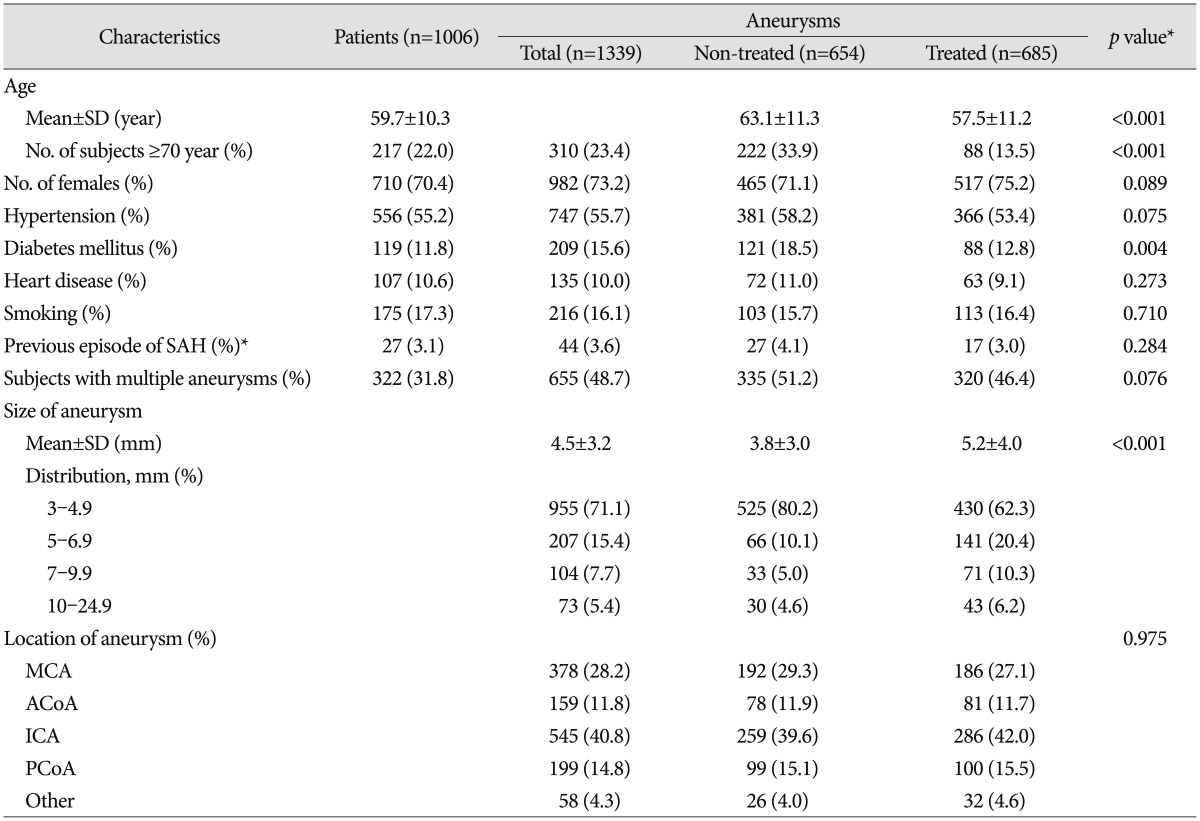1. Chalouhi N, Ali MS, Jabbour PM, Tjoumakaris SI, Gonzalez LF, Rosenwasser RH, et al. Biology of intracranial aneurysms : role of inflammation. J Cereb Blood Flow Metab. 2012; 32:1659–1676. PMID:
22781330.

2. de Rooij NK, Linn FH, van der Plas JA, Algra A, Rinkel GJ. Incidence of subarachnoid haemorrhage : a systematic review with emphasis on region, age, gender and time trends. J Neurol Neurosurg Psychiatry. 2007; 78:1365–1372. PMID:
17470467.

3. Güresir E, Vatter H, Schuss P, Platz J, Konczalla J, de Rochement Rdu M, et al. Natural history of small unruptured anterior circulation aneurysms : a prospective cohort study. Stroke. 2013; 44:3027–3031. PMID:
24003049.

4. Ishibashi T, Murayama Y, Urashima M, Saguchi T, Ebara M, Arakawa H, et al. Unruptured intracranial aneurysms : incidence of rupture and risk factors. Stroke. 2009; 40:313–316. PMID:
18845802.
5. Juvela S. Prevalence of and risk factors for intracranial aneurysms. Lancet Neurol. 2011; 10:595–597. PMID:
21641283.

6. Juvela S, Hillbom M, Numminen H, Koskinen P. Cigarette smoking and alcohol consumption as risk factors for aneurysmal subarachnoid hemorrhage. Stroke. 1993; 24:639–646. PMID:
8488517.

7. Juvela S, Porras M, Poussa K. Natural history of unruptured intracranial aneurysms : probability of and risk factors for aneurysm rupture. J Neurosurg. 2000; 93:379–387. PMID:
10969934.

8. Juvela S, Poussa K, Lehto H, Porras M. Natural history of unruptured intracranial aneurysms : a long-term follow-up study. Stroke. 2013; 44:2414–2421. PMID:
23868274.

9. Kang H, Peng T, Qian Z, Li Y, Jiang C, Ji W, et al. Impact of hypertension and smoking on the rupture of intracranial aneurysms and their joint effect. Neurol Neurochir Pol. 2015; 49:121–125. PMID:
25890927.

10. Kim JE, Lim DJ, Hong CK, Joo SP, Yoon SM, Kim BT. Treatment of unruptured intracranial aneurysms in South Korea in 2006 : a nationwide multicenter survey from the Korean Society of Cerebrovascular Surgery. J Korean Neurosurg Soc. 2010; 47:112–118. PMID:
20224709.

11. Lee EJ, Lee HJ, Hyun MK, Choi JE, Kim JH, Lee NR, et al. Rupture rate for patients with untreated unruptured intracranial aneurysms in South Korea during 2006-2009. J Neurosurg. 2012; 117:53–59. PMID:
22519434.

12. Li H, Wong KS. Racial distribution of intracranial and extracranial atherosclerosis. J Clin Neurosci. 2003; 10:30–34. PMID:
12464517.

13. Mehan WA Jr, Romero JM, Hirsch JA, Sabbag DJ, Gonzalez RG, Heit JJ, et al. Unruptured intracranial aneurysms conservatively followed with serial CT angiography : could morphology and growth predict rupture? J Neurointerv Surg. 2014; 6:761–766. PMID:
24275611.

14. Rudolph TK, Rudolph V, Baldus S. Contribution of myeloperoxidase to smoking-dependent vascular inflammation. Proc Am Thorac Soc. 2008; 5:820–823. PMID:
19017736.

15. Sonobe M, Yamazaki T, Yonekura M, Kikuchi H. Small unruptured intracranial aneurysm verification study : SUAVe study, Japan. Stroke. 2010; 41:1969–1977. PMID:
20671254.

16. UCAS Japan Investigators. Morita A, Kirino T, Hashi K, Aoki N, Fukuhara S, et al. The natural course of unruptured cerebral aneurysms in a Japanese cohort. N Engl J Med. 2012; 366:2474–2482. PMID:
22738097.

17. Unruptured intracranial aneurysms--risk of rupture and risks of surgical intervention. International Study of Unruptured Intracranial Aneurysms Investigators. N Engl J Med. 1998; 339:1725–1733. PMID:
9867550.
18. van Swieten JC, Koudstaal PJ, Visser MC, Schouten HJ, van Gijn J. Interobserver agreement for the assessment of handicap in stroke patients. Stroke. 1988; 19:604–607. PMID:
3363593.

19. Vlak MH, Algra A, Brandenburg R, Rinkel GJ. Prevalence of unruptured intracranial aneurysms, with emphasis on sex, age, comorbidity, country, and time period : a systematic review and meta-analysis. Lancet Neurol. 2011; 10:626–636. PMID:
21641282.

20. Vlak MH, Rinkel GJ, Greebe P, Algra A. Risk of rupture of an intracranial aneurysm based on patient characteristics : a case-control study. Stroke. 2013; 44:1256–1259. PMID:
23520239.

21. Wiebers DO, Whisnant JP, Huston J 3rd, Meissner I, Brown RD Jr, Piepgras DG, et al. Unruptured intracranial aneurysms : natural history, clinical outcome, and risks of surgical and endovascular treatment. Lancet. 2003; 362:103–110. PMID:
12867109.







 PDF
PDF ePub
ePub Citation
Citation Print
Print






 XML Download
XML Download